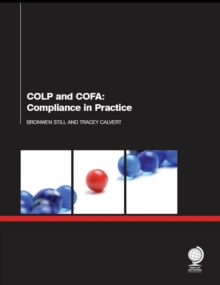MAny COMPLIAnCe officers for legal practice (COLPs) and compliance officers for finance and administration (COFAs), having agreed to take on these roles, will now be trying to understand the exact nature of their obligations and to integrate their roles as effectively as possible within their firms.
The role requirements, and the obligations which go with them, are set out only in high level terms in the Solicitors Regulation Authority (SRA) SRA Authorisation Rules 2011 and there is little official SRA guidance to help the role holders prepare. They carry significant personal responsibility and they have no real precedent in the legal profession.
COLPs and COFAs must be approved by the SRA as suitable by 31 October 2012 and after that they must be fully effective in their roles.
This report aims to de-mystify the roles and to offer practical support to help COLPs and COFAs identify and meet the SRA's requirements and use their position to bring benefits to their firms.
It also looks at who might be suitable for these roles and the experience and knowledge they are likely to need. The COLP and COFA roles are set against the backdrop of unprecedented change in the legal services market and the way these services are regulated.
The SRA now regulates not just traditional law firms but also alternative business structures (ABSs) with non-lawyer managers and owners.
To prepare for this change and to meet the consumer focused objectives of the Legal Services Act 2007 (LSA), the SRA has made radical changes to the way it regulates and what it expects of firms.
First and foremost the SRA has introduced the concept of 'outcomes focused regulation' (OFR).
From the firm's perspective, this means looking more clearly at the Outcomes that are achieved for each client and at an effective management regime which supports the provision of client services.
From the SRA's perspective, this has meant becoming more of a risk based regulator where the emphasis is on identifying how well firms are managed and, as a result, the level of risk they pose to their clients, the public and the profession.
The SRA views the COLP and COFA roles as pivotal to introducing OFR in firms, driving up standards and reducing risks to compliance. The role holders are also their firm's primary link with the SRA in an era in which much more openness is expected between regulator and regulated.
In many firms, the COLP and COFA may need to bring about a major culture change to make managers and staff more alert to their regulatory obligations and to possible risks to compliance.
Other key issues, such as how the new roles fit into the firm's management structure, will need careful thought.
This report takes a comprehensive look at all aspects of these roles.
It starts with the legal and statutory provisions which define them, who can undertake the roles and what the Rules require of them.
It then drills down in more detail into the fundamental requirement to take all "reasonable steps" to ensure compliance and what this means in practical terms.
It analyses what might comprise a compliance plan and how risks to compliance could be identified and dealt with. Because firms are now going to have to identify, record and report all non-compliance, the report looks at ways this might be done and, importantly, at what might constitute "material non-compliance" which needs to be reported to the SRA immediately. It also looks in some detail at the way the SRA has positioned itself as a proportionate, risk based regulator and, accordingly, what firms can expect as to the way they will be regulated.
This will include looking at the SRA's approach to risk and how it proposes to deal with firms it identifies as representing an unacceptable risk.
Knowing how to achieve a low risk rating and avoid falling into the SRA's new supervision regime for firms will one of the main tasks of the COLP and COFA. Because the COLP and COFA will have different areas of responsibility for regulatory compliance, the report breaks down these roles into the separate areas and looks at the detail of what is required for each in terms of systems and procedures.
In relation to the COFA role, the Accounts Rules are examined in some detail.
For the COLP role, the Code of Conduct is the main focus of attention and, in particular, how the Outcomes should be viewed in terms of compliance.
Finally, the report looks at the personal position of the COLP and COFA. It examines the extent of their responsibility as against that of the other partners or directors, how their role fits within the firm and at possible sources of help.
Key features of the report include: The attributes of a COLP and COFA; The responsibilities of the COLP and COFA; How these roles might fit into the management structure; What a compliance plan should contain; What taking all "reasonable steps" to ensure compliance means; Reporting non-compliance and what "material" non-compliance might include; The relationship between the SRA and the COLP and COFA; and The SRA's new approach to risk and its supervision regime.
Case studies and commentaries are also included covering: The similarities to the MLRO role; The nuts and bolts of compliance; and The reporting accountant's perspective.

